| |
Shrine No. |
last update:
26.03.2008
|
Data
| Shrine No. |
Name /
Transliteration |
Date |
Distance to the Speos of Haremhab
[~ m] |
Remarks |
| 15 |
Hapuseneb
¡pw-snb |
Hatshepsut |
373 |
|
| |
|
|
|
|
| All data according to Caminos, 1963 |
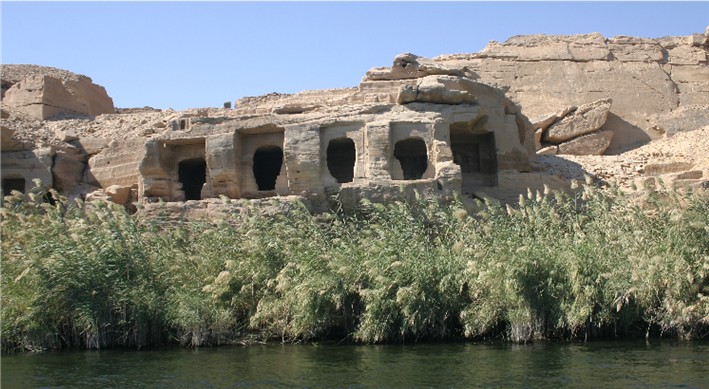
|
From right to left the shrines No.: 12 (Minnakhte), 13 (Senneferi), 14 (Nehesj),
15 (Hapuseneb), 16 (Senenmut), and - destroyed - 17 (User-amun), all built
during the reign of Hatshepsut and Thutmosis III (photo: E. Noppes). The
entrances of all shrines were set into shallow recesses formed by cutting back
the face of the rock.
|
|
The shrine of Hapuseneb (No. 15) is the 4th one from the right. The entrance of
the shrine overhangs the water's edge. The photo below
shows the entrance of shrine with its decoration. Hapuseneb was High
Priest of Amun and Overseer of the construction at KV20.
|
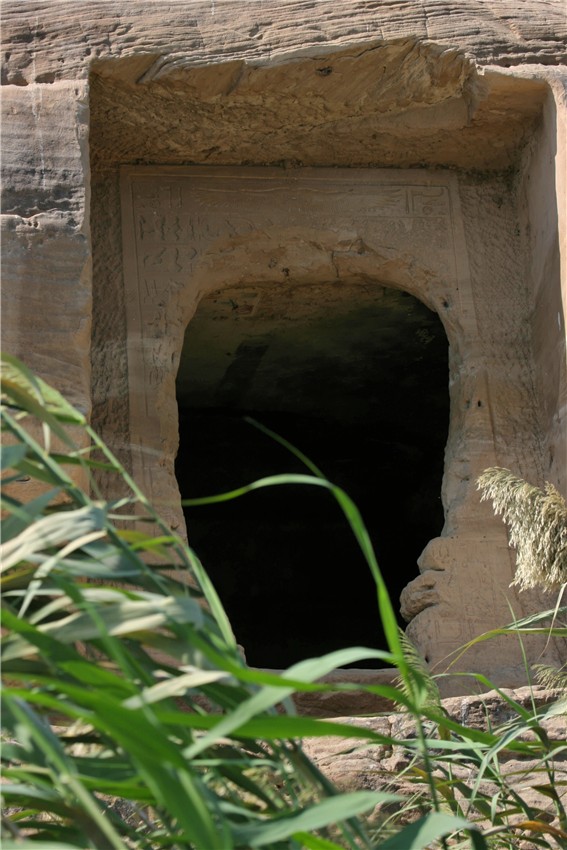
|
The following drawing taken from Caminos (1963) shows the details of
the decoration of the entrance.
|
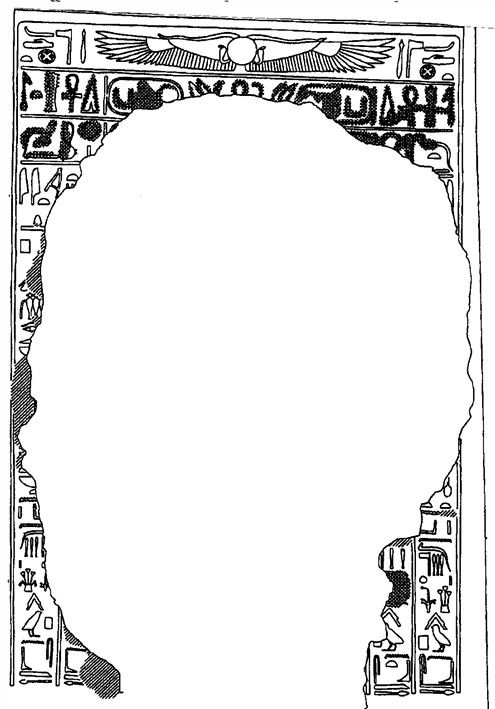
|
The doorway and the decoration are markedly damaged, from 4 registers only the
uppermost has survived intact. On both sides of the winged sun-disk the
inscription reads: "[The] Behedetite, the
great god."
|
The 2nd register reads from the central
anx-sign:
"anx nsw-bjtj MAat-kA-Ra Dj anx
Ddt ... Life to the King of Upper and Lower Egypt, Maat-ka-Ra, given
life, stability, and ....."
The inscription was destroyed deliberately, most likely under Thutmosis III. |
|
Most of the 3rd is destroyed. However, some signs and on the northern (right)
side a part of a cartouche have survived at the ends - most likely, the register
showed the name "Hatshepsut" followed by a phrase ending with "like Ra forever". |
|
In the 3rd register only a few signs of a phrase ending in a "mrj.t
beloved of" have survived on both ends.
|
|
Two columns of text had been carved on the door-jambs, but not much is left.
Both columns end with a title and the name of the "justified" Hapuseneb.
|
|
The text of the inner column on the northern (right) side reads "..
Hm-nTr tpj n Jmn ¡pw-snb maA xrw... high priest of
Amun, Hapuseneb, justified", with the name of Amun erased by the Akhenaton
iconoclasts. |
|
On both outer columns identical parts of the text have survived ".. jmj-ra
Hmw-nTr ^maw MHw ¡pw-snb maA xrw.... overseer of the priests of Upper and
Lower Egypt, Hapuseneb, justified". |
|
The entrance which was initially about 77 cm wide and 165 cm high had been
crudely enlarged. The entrance leads into a shrine which consists of a single
room which is about 73 cm wide, 368 cm deep and 190 cm high. All walls had been
decorated with an excellent low relief, now badly damaged. Here and again, a few
traces of colors have been preserved. Opposite to the entrance a niche had been
carved into the west wall. The niche which contains a now defaced seated statue
of Hapuseneb is about 70 cm wide, 135 cm high, and at maximum 66 cm deep.
Hapusenebs feet rest on a low dais that projects about 10 cm into the room. |
|
The flat ceiling is divided into two parts by a inscribed band running from east
to west. The greater part of the inscription is lost, however, based on the
preserved signs it can be concluded that it contained an usual formula of
funerary offerings. The text starts with "@tp-Dj
nsw ... A boon which the king gives [to Amun]", the name of the god has
been erased by the Atenists. |
|
On both sides of the central band the ceiling has been decorated with a
checkered pattern of colored squares. Alternating these squares contained
smaller central squared. The border along the walls was a painted band, however,
the color cannot be determined anymore. Inside this band contained, at
intervals, small green triangles. |
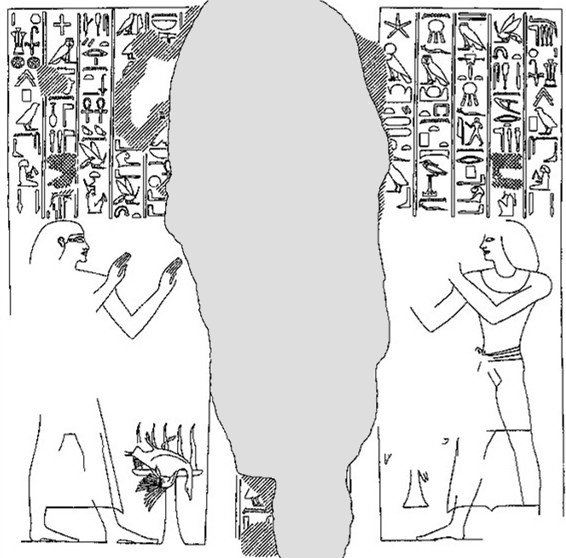
|
The drawing above (Caminos, 1963) shows the decoration of the east wall at both
sides of the doorway. |
|
On both sides of the doorway the owner of the shrine, Hapuseneb, is depicted
facing the entrance and lifting both arms in a reverential gesture. Before
Hapuseneb an offering-table is shown. To the northern (here the left) side the
table bears a duck with flames arising behind it. On the opposite side the
corresponding part of the scene is damaged but traces suggest another
offering-table bearing a duck. |
|
On the left side of the doorway a very few signs have survived, remnants of a
band of text which ran - perhaps completely - along the inner part of the
doorway. |
|
The two areas with inscriptions above the figures of Hapuseneb contain an
adoration of Amun[-Ra] (left) or Ra-Horakhti (right). Both inscriptions end with
titles and the name of Hapuseneb. |
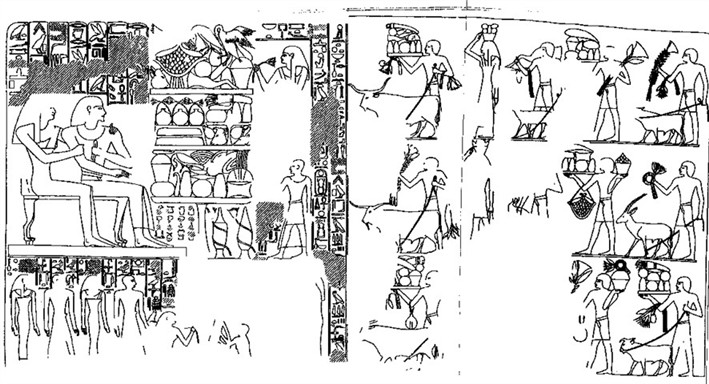
|
The drawing above (Caminos, 1963) shows the decoration of the north wall. |
|
The northern inner wall is divided into several scenes. On the left two
registers are shown one above the other. In the upper register Hapuseneb, and,
behind him, his mother Ah-hotep are shown seated in front of a table with
offerings. |
|
Right opposite two smaller figures are depicted one above the other. The upper
one is a lady who holds a lotus flower in her hand. The text identifies her as
the "Lady of the House, Amen-hotep", the wife of Hapuseneb. |
|
The male below her might have been a son of Hapuseneb, however, that is not
attested by the accompanying text. According to the text he was 2nd lector
priest engaged in the mortuary cult of Thutmosis I, but the name is a puzzle and
not attested by other records. |
|
The lower register shows the family of Hapuseneb, from right to left: kneeling
his sister Ahmose, justified, his son Djehutjmes-machet,
his daughter Henut, his son User-pechtj, and far left his
daughter Henut-neferet. Opposite to the members of his
family comes the figure of a harpist followed by the figure of a woman who was
probably shown clapping. |
|
The right side of the northern shows 15 offering-bearers arranged in three
registers. The offering-bearers bring cakes, bread, flowers, fruit, vegetables,
meat, and livestock. |
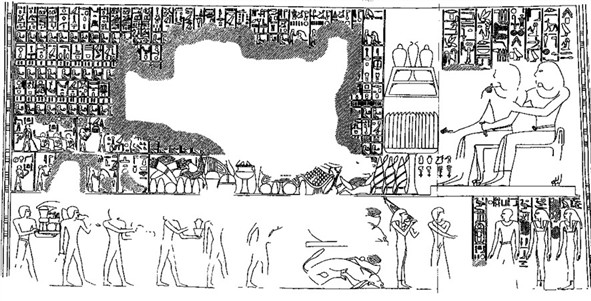
| The drawing above (Caminos, 1963) shows the decoration of the south wall.
|
|
The south wall shows a set of scenes similar to those found on the north wall.
At the west (right) end Hapuseneb und his father Hapu are shown seated before a
table of offerings. |
|
Below them, at the beginning of a long registers that runs along the whole wall,
three other children of Hapusenen are depicted: first his son Aa-cheper-ka-ra-nefer,
followed by two daughters, Sen-seneb and Ta-em-resefu. |
|
Facing the children two figures are depicted, a man, stretching his right arm
forward, and the left hand resting on his right shoulder (a dancer?), followed
by a female harpist. Behind them two slaughtered oxen are shown. The remainder
of the register shows six offering-bearers. |
|
The greater part of the wall, opposite to Hapuseneb and his father, is occupied
by a list of offerings arranged in 4 registers. A large area of the decoration
has been destroyed. |
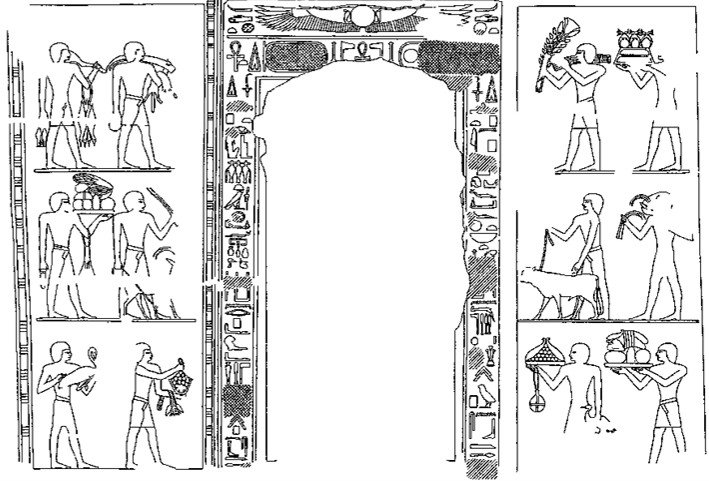
|
The drawing above (Caminos, 1963) shows the decoration of the west wall. |
|
The west wall is dominated by the niche with the much defaced seated statue of
Hapuseneb. The niche is surrounded on three sides by inscriptions. The lintel is
divided into two registers, the upper one contains the winged sun-disk with the
accompanying inscription "[The] Behedeti "
at either ends. |
The 2nd register below is partly damaged, however, Caminos reconstructs the
following text running on both sides and starting with the central
anx-sign:
"anx nfr nTr MAat-kA-Ra Dj anx ...
Life to the God God, Maat-ka-Ra, given life",
whereby the feminine form was used on the left side. |
The northern (right) inscription on the jamb reads:
"A boon which gives the king to Anubis, who is on his mountain, that he
may give everything good and pure [to] the spirit of the overseer of prophets of
[Upper] and Lower Egypt, Hapuseneb, justified". |
The southern (left) inscription reads:
"A boon which
gives the king to Osiris, the foremost of the westerners, that he may give
invocation-offerings consisting of bread, beer, oxen, and fowl [to] the spirit
of the hereditary prince and count, first prophet [of Amun], Hapuseneb,
justified".
|
|
To the right and the left of the nice large panels divided into three registers
each show two offering-bearers per register - which are already bringing the
desired gifts. |
|






